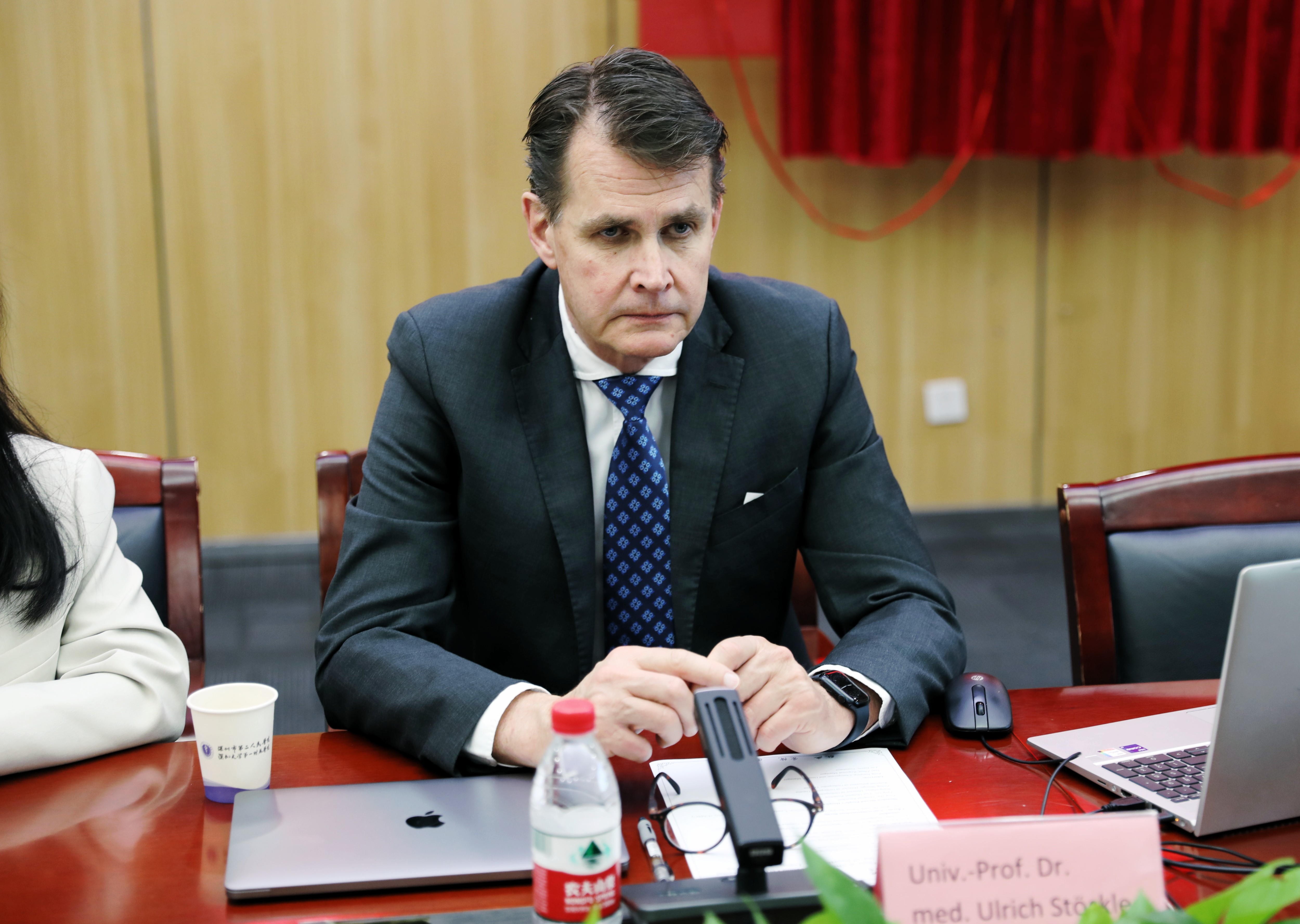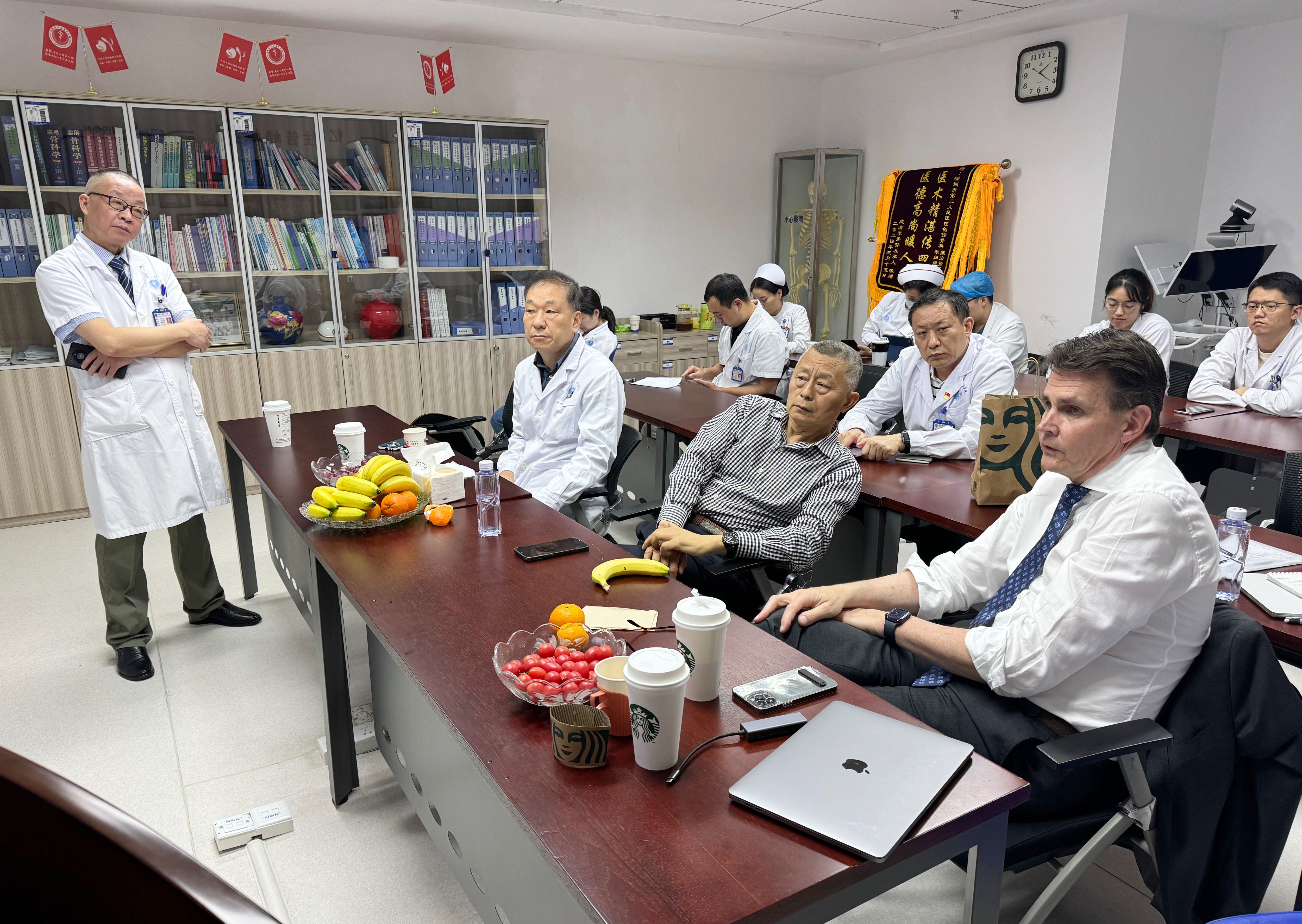-
News & Events

From April 15th to 19th, Prof. Stöckle, the Managing Director of the Center for Musculoskeletal Surgery of Charité (CMSC), President of AO Trauma Germany, and President-elect of the German Society for Trauma Surgery 2025, arrived at Shenzhen Second People’s Hospital for a week-long international visiting professorship, and carried out a series of academic exchange activities, including outpatient consultations, ward rounds, surgical guidance, internal symposiums, discussions on complex cases, and public lectures, etc.
Highlights
Only those with a pure heart can make great achievements, and those with a complicated mind cannot, since they never dedicate themselves to one thing. Only those who are single-minded, pursuing the perfection of medicine, can become a master. Since Prof. WANG Manyi from Beijing Jishuitan Hospital moved from Beijing to Shenzhen Second People's Hospital, it has taken him five years, nearly two thousand days and nights, to greatly attract patients, standardize department management, and complete specialty construction. He is a real top orthopedic master with global thinking. During Prof. Stöckle’s visit, Prof. WANG Manyi discussed with Prof. Stöckle on diagnosis, treatment, cases and education for young surgeons in English everyday. Prof. Wang possesses a charming and influential personality. He is truly a trauma master in China. He led Beijing Jishuitan Hospital to start a new era of orthopedics in China. Now he continues to lead the Orthopedics Dept. of Shenshen Second People's Hospital to strive for new progress. Prof. WANG attended his first AO Course in 1989 and served as the President of AO Trauma Asia Pacific from 2015 to 2018. This visiting professorship not only fosters communication between the two hospitals but also further deepens the AO's educational concepts in China. Prof. Stöckle and Prof. WANG both recognize the significance of AO in building a global network for trauma surgeons, providing better continuing education for physicians, and promoting international exchanges in this field. Prof. Stöckle encourages young doctors to improve their language skills, while cultivating clinical and research skills, and to actively participate in academic exchanges through international organizations like AO. Sino-German trauma masters meet at Shenzhen Second People's Hospital in a pleasant atmosphere among the attendees. China and Germany have established cooperation for 40 years and have been highly interdependent on each other. One should dedicate to one career in a life, and devote his whole life to it. The core of Gloryren is to improve Grade Three Class A hospitals in China with our efforts. We are able to foster an average doctor into an excellent one and even a top one in the future. And we are able to improve the healthcare system in China.
Inauguration Ceremony for Sino-German Communication Center for Orthopedic Trauma
On the morning of April 15th, a welcome ceremony for Prof. Stöckle was held at the Shenzhen Second People’s Hospital jointly by ZENG Hui, Hospital President, YANG Lei, Vice HospitalPresident, WANG Manyi, Director of Dept. of Orthopedics, ZHANG Shengli, Director of Dept. of Orthopedic Trauma, and the team of Orthopedic Trauma. Afterwards, the two parties jointly moderated the inauguration of the “Sino-German Communication Center for Orthopedic Trauma”.

President Zeng welcomed Prof. Stöckle in good German.

Prof. Wang communicated with Prof. Stöckle in fluent English throughout the event.

Prof. Stöckle introduced at the welcome ceremony that Charité – Berlin University Medicine, founded over 310 years ago, has been listed top five in the World's Best Hospitals Ranking by U.S. Newsweek for many years and top one in multiple national rankings in Germany. The Center for Musculoskeletal Surgery (CMSC), led by Prof. Stöckle, was established in 2003 and is the largest of its kind in Germany.

Lecture on the Treatment of Proximal Humeral Fractures
On the afternoon of April 15th, Prof. Stöckle delivered an internal lecture on the topic of “Proximal Humeral Fractures: Open Reduction and Internal Fixation VS. Reverse Total Shoulder Arthroplasty”, elaborated the indications for these two surgical techniques with cases. The team of orthopedic trauma then discussed with Prof. Stöckle the two proximal humeral fracture cases and one patellar fracture case scheduled for operation for the following day.

Prof. Wang attended his first AO Course in 1989 and served as the President of AO Trauma Asia Pacific from 2015 to 2018. This visiting professorship not only fosters communication between the two hospitals but also further deepens the AO's educational concepts in China.

Both Prof. Stöckle and Prof. Wang both recognize the significance of AO in building a global network for trauma surgeons, providing better continuing education for physicians, and promoting international exchanges in this field. Prof. Stöckle encourages young doctors to improve their language skills, while cultivating clinical and research skills, and to actively participate in academic exchanges through international organizations like AO.

Case Presentation and Discussion of Surgical Plan
On the morning of April 16th, Prof. Stöckle participated in case discussion moderated by Prof. WANG Manyi, Director of Dept. of Orthopedics and Prof. ZHANG Shengli, Director of Dept. of Orthopedic Trauma. The team of orthopedic trauma of presented cases on ankle fracture, patellar fracture, distal radial fracture, tibial plateau fracture, proximal humeral fracture, and calcaneal fracture. Prof. Stöckle, Prof. WANG, Prof. ZHANG, along with the presenters, discussed the surgical plans for each case in detail.

After the morning meeting, Prof. Stöckle, together with Director Zhang, had a ward round.

Prof. Stöckle then visited the OR and observed two open reduction and internal fixation (ORIF) operations for proximal humeral fracture and for ankle fracture and an osteotomy for elbow varus. Prof. Stöckle highly acknowledged the treatment concepts and surgical techniques of the team headed by Prof. Wang and Director Zhang, and expressed great anticipation for the scheduled operations and case discussion on Wednesday.

Surgical Observation
On the morning of April 17th, Prof. Stöckle visited the OR and to observe the planned operations . Subsequently, Prof. Stöckle observed an ORIF for patellar fracture and an ORIF for ankle joint fracture carried out by the team from the Dept. of Orthopedic Trauma, another ORIF for ankle joint fracture performed by the team from the Dept. of Hand and Foot Surgery, as well as a PFNA for intertrochanteric femoral fracture by the Orthogeriatrics team from the Dept. of Joint Surgery. Prof. Stöckle had a intensise exchange with the surgeons on the selection of surgical approach and implant and the use of intra-operative imaging, etc.

Department Case Discussion
On the afternoon of April 17th, Prof. Stöckle participated in an internal case discussion led by Prof. WANG Manyi, Director of Dept. of Orthopedics and Prof. ZHANG Shengli, Director of Dept. of Orthopedic Trauma.

Based on the operations he observed in the past few days, Prof. Stöckle started with 5 cases of upper limb fractures and 1 polytrauma case.

Following that, Dr. CHEN Lei, a Deputy Chief Physician, reported a case of revision of terrible triad of elbow. Dr. XU Xu, an Attending Physician, presented a case of tibial plateau fracture.


The case discussion was chaired by Prof. Wang and lasted for over 2 hours with heated discussion and active involvement from young surgeons. All of them expressed that they had benefited a lot and were looking forward to the Sino-German Trauma Master’s Public Lecture Shenzhen on Thursday.

Sino-German Trauma Master’s Public Lecture Shenzhen
On April 18th, the Sino-German Trauma Master’s Public Lecture Shenzhen was held at the Yinhu Training Center of Shenzhen Second People’s Hospital. The event was moderated by Director ZHANG Shengli and kick off by an opening spech by Prof. WANG Manyi.
Before the lecture started, Prof. Stöckle gave a short speech, expressing his gratitude for being invited to the Dept. of Orthopedic Trauma at Shenzhen Second People's Hospital as a international visiting professor and for the warm hospitality by Prof. Wang and Director Zhang during the past week, which provides him with a deeper understanding of the development of orthopedic trauma in China and a more profound insight into Shenzhen, a young, vibrant, and international modern metropolis.

On behalf of AO Trauma Germany and the Center for Musculoskeletal Surgery of Charité, Prof. Stöckle gifted customized T-shirts to Prof. Wang and Director Zhang, extending a warm welcome for their visit to Germany.

Prof. Stöckle began his lecture with the topic of “Tibial Plateau Fractures: Analysis, Classification and Strategies”. Prof. Stöckle emphasized that the treatment of tibial plateau fractures must adhere to the most basic principles, that is, the decision of surgical timing and approach must be made upon thorough evaluation and analysis of the condition of soft issues, injury mechanism, and understanding of the fracture through X-rays and 2D/3D CT imaging.

Prof. Stöckle proceeded to introduce the classic classifications for tibial plateau fractures, including AO Classification, Schatzker Classification, Three-column Classification, etc. Alongside relevant cases, Prof. Stöckle explained in detail on classifying fractures based on the morphology and injury mechanism, selecting suitable surgical approaches and implant, applications of intraoperative imaging, and surgical techniques according to the respective classifications.
After a short and heated discussion with the attendees on tibial plateau fractures, Prof. Stöckle lectured on “Acetabular fractures – What can we expect?”. The goal of the treatment of acetabular fracture is the anatomic reconstruction of the joint and stable osteosynthesis, with the reduction criteria of gap / step < 1-2mm. The choice of the surgical approach is of critical importance and is markedly dependant on fracture morphology. For fractures of posterior acetabulum, the KL approach is recommended, as it allows address of the entire posterior acetabulum and direct reduction of the fracture.

However, with the growing problem of an aging population, the average age of patients with acetabular fractures has risen from 45 to 77 years during the past 20 years, and the type of fracture in most cases has transferred from a high-energy injury in the posterior acetabulum to a low-energy injury in the anterior column of the acetabulum.
The three commonly used approaches for anterior acetabular fractures are the ilioinguinal approach, the modified Stoppa approach, and the pararectus approach. Prof. Stöckle then thoroughly analyzed these three approaches by cases in terms of intra-operative direct insight and accessibility, selection of implant and surgical instruments selection and surgical techniques, and compared the clinical efficacy of the three approaches by citing literature and internal data from CMSC.
The classic ilioinguinal approach is now less commonly used in Europe. Literature and data have shown that the pararectus approach has at least equal clinical results to the modified Stoppa approach, with significantly better exposure. Compared with the ilioinguinal approach, the pararectus approach has significantly better reduction quality with no difference in rate of complications, and promising results.
Over the past few years, Prof. Stöckle and his team have developed a laparoscopic approach for plate osteosynthesis of the pelvic ring and acetabulum, which is expected to further promote minimally invasive treatment for acetabular fractures. Prof. Stöckle also highlighted that the choice of surgical approach depends the patient's conditions and the surgeon's personal experience and proficiency. Prof. Stöckle proposed that the future of acetabular fracture treatment is highly promising with the developments in intra-operative imaging, new surgical approaches, and technical advancements, and it will no longer as difficult as before though still challenging.
Later, HUANG Junfeng, a Chief Physician from the Dept. of Orthopedic Trauma of Shenzhou Second People’s Hospital presented a case on the treatment of a severely injured polytrauma patient.

HU Xinjia, the Director of the Dept. of Orthopedic Trauma in Shenzhen People’s Hospital reported a case of treating a pelvic fracture with elastic intramedullary nails.

GAO Yanjun, the Director of from the Orthopedic Trauma Department of Luohu Hospital of Traditional Chinese Medicine (TCM), presented a case of acetabular fracture.

Prof. Stöckle, Prof. Wang, Director Zhang, and all attendees had heated discussions about the presented cases.

During the closing remarks, Prof. Wang expressed his hope that the orthopedic trauma community in Shenzhen should seize the opportunity of the ““China Tour of International Trauma Master 2024” in Shenzhen Second People’s Hospital, to reinforce cooperation and exchanges with international colleagues, jointly working towards promoting the clinical and research capabilities in orthopedic trauma throughout Shenzhen.
